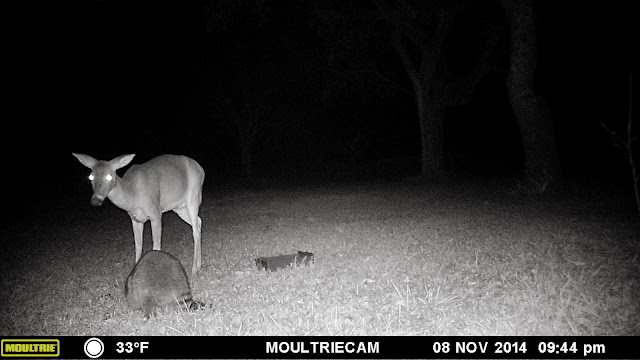I was leaving to go to town the other morning when I noticed a furry animal down near the deer feeder. It looked like a raccoon, but we normally do not see them during the day. As I cautiously approached it, it turned to look at me and there were the trademark bandit mask around its eyes.
It stared at me and I stared at it. It was a stand-off. I worried that something was wrong for it to be out in broad daylight. But, as I approached, it ran over to a nearby tree and started to climb. It stopped at the first large branch and looked down at me.
 It was very shy and tried to stay on the other side of the tree from where I was. I decided it was a young raccoon who had not yet learned to stay hidden during the day. Or, perhaps it was just very hungry. At any rate, I went on to town thinking it would be gone by the time I got back. This tree is only about 30 feet from a creek and most of that 30 feet is covered with brush and tall grass. So, there was plenty of cover in which it could hide.
It was very shy and tried to stay on the other side of the tree from where I was. I decided it was a young raccoon who had not yet learned to stay hidden during the day. Or, perhaps it was just very hungry. At any rate, I went on to town thinking it would be gone by the time I got back. This tree is only about 30 feet from a creek and most of that 30 feet is covered with brush and tall grass. So, there was plenty of cover in which it could hide.
When I got home, I didn't see it and breathed a sigh of relief. I really did not want a raccoon hanging around this close to the house and chicken coop. Raccoon are notorious for killing chickens and, with their dexterous "fingers", they are able to undo latches and things that most animals cannot.
However, my relief was short-lived as later in the day I noticed something round far out on a limb, high up in the same tree. At first I thought it was a squirrel nest. You know how squirrels make nests out of small branches and leaves. But, this just did not look quite like that and while I was observing this "thing", it moved. It was the raccoon. It was curled up in a ball and appeared to be waking up from a nap.
I knew it would come down as soon as it got dark and I was worried. The outside door of the chicken coop is only secured by a hook-and-eye sort of latch. To easy my worry, Tom went to town and bought a better latch to go on the door. Also, a friend suggested that we try to trap the raccoon in a "live" trap and relocate it. Thankfully, we have a larger trap than the one in which we caught the opossum recently (Mouse Trap Mystery).
During the night, our wildlife camera captured pictures of the raccoon after it descended to the ground.
I love the look on the deer's face!
Luckily, the raccoon ventured into the trap shortly after these pictures were taken. Here it was the next morning.
I felt really sorry for it because it was obviously scared. I put a blanket over the cage until Tom had time to haul it off. He took it out to a secluded area beside a creek and let it go. Hopefully, like the opossum, it learned from this experience and will stay well away from humans in the future.

































